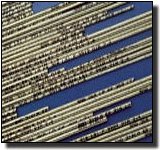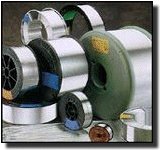 |
 |
|
Home |About Us | Product Information | Contact Us | Feedback I |
| E -
Low
heat input arc welding electrode.
A -
Bare rod for gas
welding, brazing, soldering, GTAW/GMAW |
 |
| AF -
Special flux coated
rod for speedy gas welding and brazing without the use of additional flux. F - Special corresponding flux for
filler rod. It indicates |
 |
Evolution
of Welding Technology
Back to Top
| Ever since man discovered metal, he has put it to countless uses in his everyday life. He has learnt to extract it from its ores, purify it, alloy it with other metals and shape it for his needs. In the process he acquired many techniques to give it strength and durability. |
 |
| When metal parts wore out or cracked he learnt to repair and reclaim them. The first primitive steps in this process were forging and soldering. Over the years and especially during the last two centuries, welding technology has evolved into a sophisticated science not only to join metal parts together but to reinforce them with strength that could withstand tremendous operational stresses. | |
Today, through welding technology one can join almost any metal of any size, shape, thickness, composition, etc. In fabrication, this technology can help weld crucial parts in nuclear reactors, spacecrafts, all kinds of machinery and even electronic gadgets to a very high degree of reliability. The processes developed include Oxy Acetylene Gas System, Metal Arc Welding and more sophisticated processes like Gas Tungsten Arc and Electron Beam Welding etc. These developments in welding technology have been adopted to the Oerlikon-Fon Maintenance System to suit all kinds of needs, especially in the repair and reclamation of critical industrial metal parts, components and tools.
The
Need for Conservation Back to Top
| The widespread use of metals in everyday life from household gadgets to industry and spacecraft has led to an increase in the demand for all types of metals like iron, steels, aluminium and its alloys, cobalt, chromium, nickel etc. Cost of these metals has risen steadily and resources are depleting fast. Wear and tear of machinery results in million of dollars worth metal parts ending up in the scrap yard. |  |
|
|
 |
Importance of Reliability in Weld Treatment Back to Top
As important as the need for conservation is the need for reliability in reclaiming the worn out metal parts. Welding necessitates heat input that generates stress on the metal being reclaimed. This could cause cracks, distortion, warping or weakening of the metal thus defeating the purpose and usefulness of the component. Hence in maintenance welding one must take precautions to avoid the detrimental effects of heat input. Oerlikon-Fon technology has developed products and processes which ensure very high reliability of weld reclaimed parts through :
Procedures,
Precautions and their Importance Back to
Top
In any welding job done with Oerlikon-Fon products and processes the procedures and precautions play a vital role. These have been developed to enhance the reliability of weld-reclamation.
For example, in the case of Cast Iron Welding (which is considered to be difficult) the following procedures are to be adopted :
Oerlikon-Fon combines the advantage of welding technology with the specific needs and properties of the metals to be welded. As shown in the example of cast iron welding, proper procedure and care is needed to achieve success in any reclamation job.
Recycling of Waste Resources Back to Top
Parts that are lying in your scrapyard, your maintenance workshop and in your inventory, form substantial resources for your Company. These can be weld-reclaimed with Oerlikon-Fon technology, at a fraction of their original cost. Your Company can thus earn sizeable profits and reduce operational costs resulting in continuous increased productivity. Needless to add, your spare parts inventory cost can be cut down by over 50%
Maintenance Programme Back to Top
Take a look at the scrap in your yard, the inventory of spares required, the money spent on new parts, production losses while you wait for replacement, and you will see the need for a planned Maintenance Programme; a system that calls for better utilisation of resources and offers substantial savings through planned maintenance.
Proper techniques such as, 'ABC' and 'VED' analysis coupled with sound organisational status and functional responsibilities for the maintenance division would go a long way to increase efficiency and production at minimum expense.